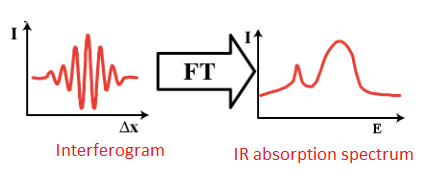Instrumentation and Working Principles of Solutions Infra Red (IR) Spectroscopy
When two atoms combine to form a stable covalent molecule, there are two repulsion forces acting between the two atoms. One is between the positively charged nuclei of both the atoms and the other between the negative electron clouds. The only other force which keeps the molecule intact is the attraction between the nucleus of one atom with the electrons of the other atom. Balancing the forces between them, the two atoms settle at a mean internuclear distance or the bond length where the total energy of the system is minimum. Any change like pulling the atoms away or squeezing them brings a change in the bond length which requires an input of energy.
A diatomic molecule with the above description is considered as two vibrating masses that are connected by a spring. The internuclear distance between the atoms at energy minima is referred to as the equilibrium distance (re). Any change in this distance is given by Hooke's law as
f = -k(r-re)
Where f is the restoring force, and r is the bond length. The energy associated considering the energy curve to be parabolic is given as : E= 1/2k(r-re)2. This equation is also known as the Morse Potential curve, which approximates the anharmonic motion of the atoms to a harmonic oscillator.
For any harmonic oscillator, when the bond vibrates, its energy of vibration is changing continuously and periodically from kinetic to potential energy and back again. The total energy is proportional to the frequency of vibration and is given as:
Eosc = h¦Íosc
The elastic nature of the bond has an intrinsic vibrational frequency which is determined by the force constant K of the spring or its stiffness, the masses of the bonded atoms.

where c is the speed of light, and μ is the reduced mass of the system, which is given by:
μ = m1m2/m1 + m2
The value of the force constant varies from the bond to bond. K for a triple bond is three times those of a single bond, and for a double bond, it is twice that of a single bond. There are two significant features that can be drawn:
- Strong bonds have large force constants and vibrate at a higher frequency than the weaker bonds.
- Bonds between the heavy atoms (larger reduced mass) vibrate at a lower frequency than that of bonds between the lighter atoms.
This is contrary to the usual picture drawn that more bonds mean more stiffness and less frequency of vibration. This, at the same time, also means that the energy of vibration for a triple bond is three times that of a single bond.
The Infrared Spectrometer: The infrared spectrometer or the spectrophotometer is the instrument that determines the IR absorption spectra of a compound. There are two types of spectrometers that are widely used in laboratories. a. Dispersive infrared spectrometers b. Fourier-Transform spectrometers

Figure 2: The main components of a Fourier transform infrared (FTIR) spectrophotometer.
Picture source: Fourier Transform Infrared Spectroscopy of Metal Ligand Complexes
FT-IR spectrometers are modern spectrometers that provide the spectrum more rapidly than the dispersive ones. The optical pathway produces a pattern called the interferogram. This is a complex signal which is a plot of intensity versus time. For more practical purposes, this time-domain spectrum is converted to a frequency-domain spectrum, that is, intensity versus frequency. This conversion is done by a mathematical operation called a Fourier-Transform (FT). FT separates the individual frequencies from the interferogram producing a virtual spectrum identical to the one obtained from dispersive spectrometers. The biggest advantage of using FT-IR spectrometers is that it is possible to collect the number of interferograms of the same sample in less than a second. When a Fourier-Transform is performed, a sum of all the interferograms gives a spectrum that has a better signal-to-noise ratio. Greater speed and greater sensitivity make FT-IR spectrometers preferred over dispersive spectrometers.

Figure 3: FT-IR spectrophotometers collect the interferograms of the sample and Fourier-transform them to an absorption spectrum.
